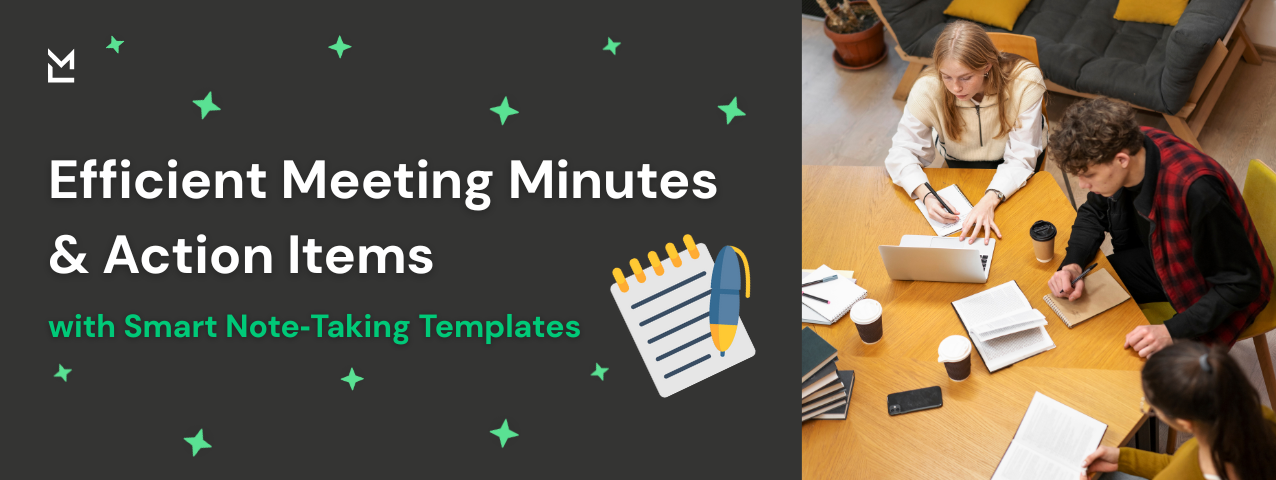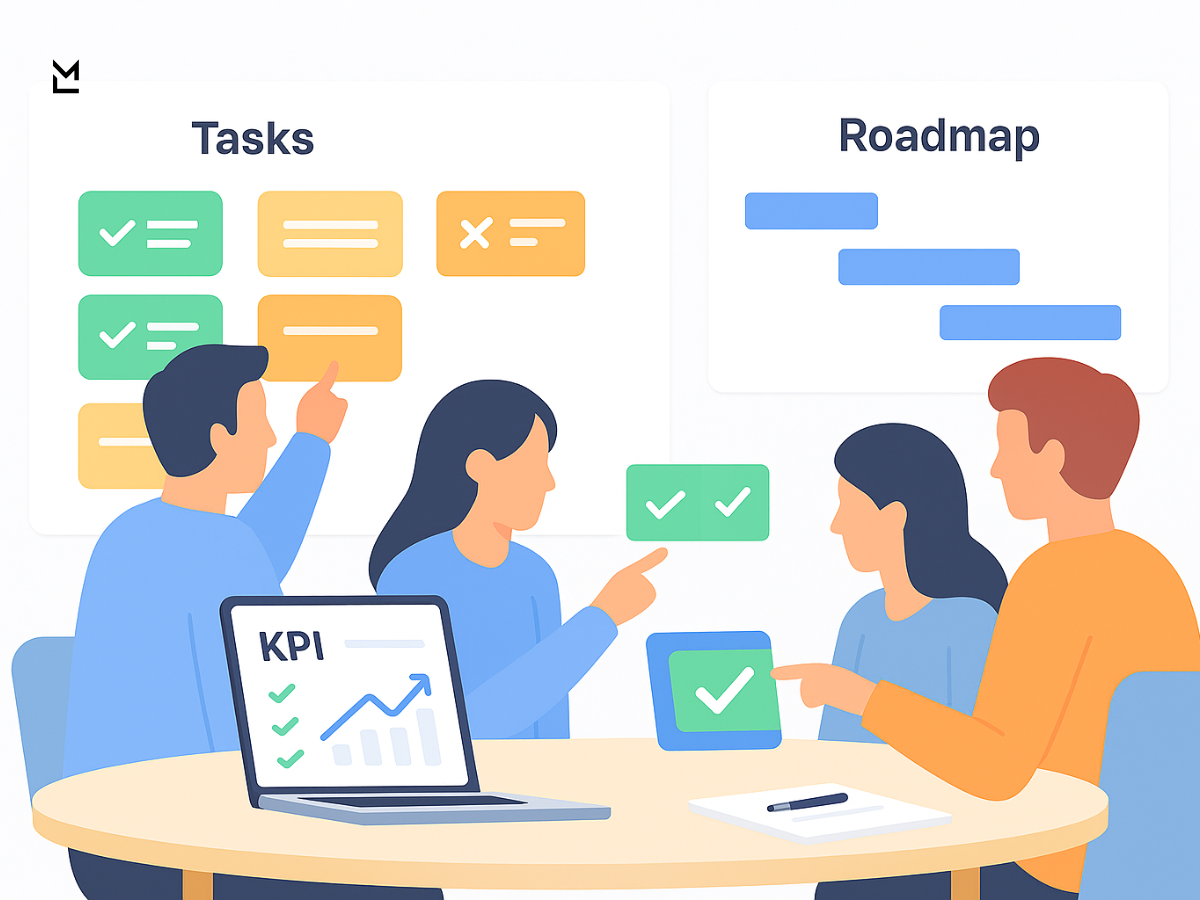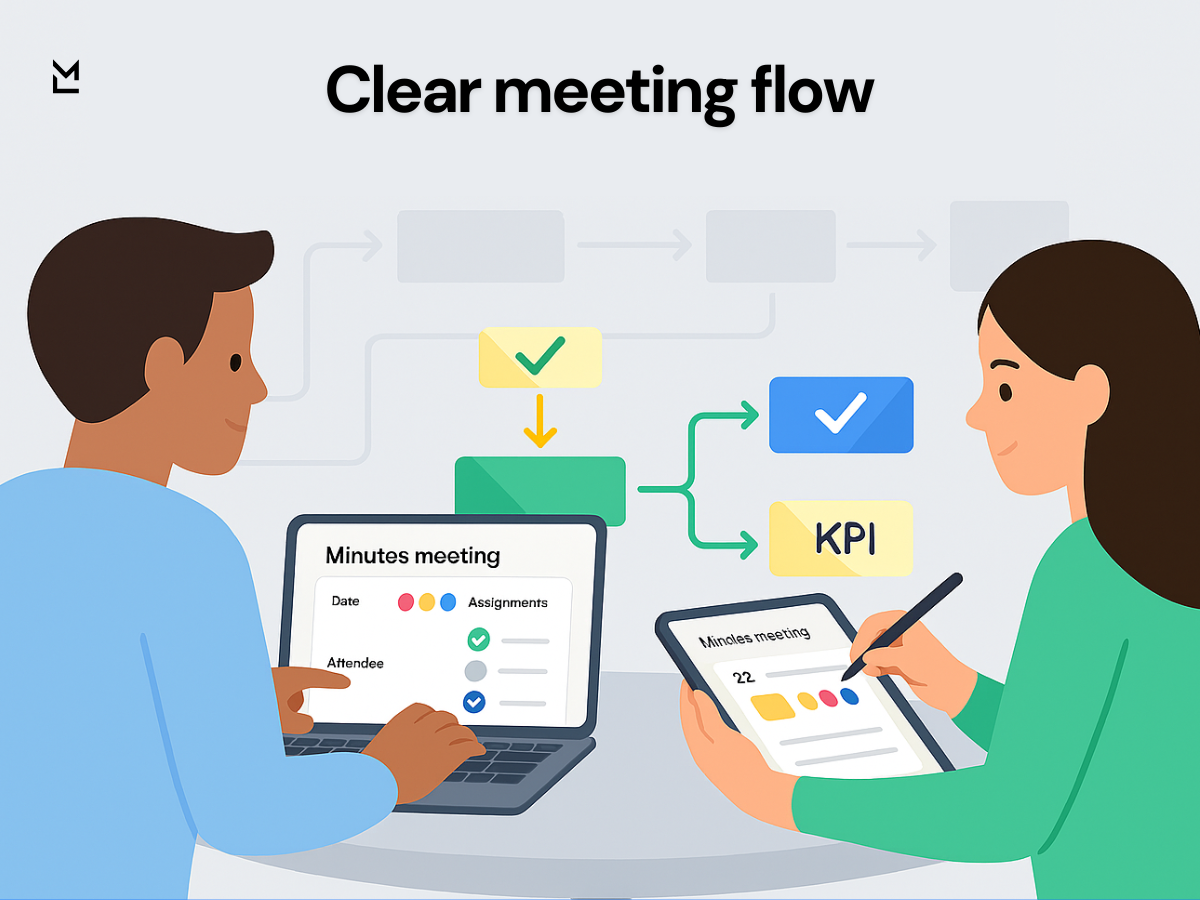
Written with help from MinutesLink - free AI meeting notetaker for online meetings.
Written with support from MinutesLink — a free AI notetaker for online meetings.
In many organisations meetings happen all the time and yet very few produce the clarity needed for change to happen. When you create effective meeting minutes you give your team a tool that captures context, meaning and decisions made in the previous meeting and sets the stage for the subsequent meeting. That’s why understanding the basics of meeting minutes and using the right meeting minutes template is key to improving business processes.
Meeting minutes are not just pages of notes. They are an action plan in disguise. They define the objectives of the meeting, track the tasks assigned to each person and clearly outline the outcomes that matter. When treated as part of a continuous improvement approach they support methods like the PDCA cycle, Six Sigma, lean manufacturing and other process improvement techniques that help identify where efficiency can be improved.
Good minutes also reduce repetitive tasks because everything is documented and easy to find. Team members don’t have to revisit the same conversations or reconstruct what was discussed. They just act.
Action items are the backbone of efficient meetings. When an action item is clear, measurable and linked to a person it’s much easier to track progress and hold people accountable. A good action item includes what needs to be done, why it matters, who is responsible and when it needs to be done. That kind of clarity eliminates guesswork and makes the workflow smoother.
In project management and task management environments action items are essential for momentum. They define priorities, outline objectives and turn discussions into concrete steps that improve processes. Organisations that use action items consistently see significant improvements in productivity and customer satisfaction because nothing falls through the cracks. Teams that treat action items as part of their continuous process improvement strategy can measure over time. They can see what works, what doesn’t and what solutions are worth exploring. That’s the essence of business process improvement: a consistent, structured effort to refine existing processes and create new ones where needed.
A meeting notes template is a guide that keeps everything in order and consistent. Instead of improvising every time you have a meeting you have a structure that captures the date, the group attending, the discussions reviewed and the tasks assigned. Templates make it easier for teams to focus on what matters because the format highlights key performance indicators and ensures nothing important is missed.

Whether you create your templates in Google Docs or Microsoft Word the structure helps with organisation and makes it easier to track progress. Templates also support better process mapping and stream mapping because they are a snapshot of the meeting environment. This is especially valuable for large teams or distributed organisations where written communication affects business operations.
Standardising notes makes things more efficient. Team members know where to find information, how to interpret it and how to act on it. Over time consistency contributes to total quality management because the organisation develops a habit of documenting, reviewing and improving its systems.
Meeting notes become even more valuable when they become a clear action plan. An action plan defines goals, methods and tasks in a way that aligns with business operations. It sets expectations, clarifies responsibilities and creates accountability. This is especially important in organisations where workflows depend on team coordination.
Turning meeting notes into an action plan involves identifying areas for improvement and organising tasks in a way that supports continuous improvement. As teams track their progress they learn to adjust. They can act faster, analyse better and plan smarter. This leads to better outcomes and improved efficiency.
Notes also play a big role in connecting discussions with potential solutions. When ideas are documented they can be reviewed later to assess their relevance based on market changes and customer expectations. That’s why creating good meeting notes is key to long term success.
Process improvement involves observation, analysis and adaptation. For organisations that want to improve business processes documenting meetings is essential. The written record helps identify recurring issues, evaluate existing processes and understand how teams work. It becomes easier to define workflows, map value streams and understand where bottlenecks occur. Organisations that prioritise continuous improvement rely heavily on good documentation habits. This includes organising meeting notes, reviewing outcomes and creating templates that support better decision making. Continuous process improvement depends on being able to measure performance and track how process changes impact key performance indicators.
Meeting notes also support methodologies like Six Sigma and total quality management because they capture information that would otherwise be lost. When discussions, ideas and solutions are documented teams can make better decisions and evolve their systems over time.
Many inefficiencies come from unclear communication. When teams don’t know what was decided, who owns what task or what the objectives are productivity drops. Clear meeting notes solve these issues by organising conversations in a way that eliminates confusion and reduces repetitive tasks.

Notes influence collaboration by providing shared understanding. When someone joins a project late or needs to review previous decisions the notes explain everything clearly. This reduces the time spent catching up and improves task execution. It also ensures progress is measurable and outcomes align with business goals.
The more accessible the meeting notes are the easier it is for teams to track progress and adapt. Teams can analyse patterns, understand challenges and rethink their systems to reduce costs and improve the customer experience.
Some teams struggle to keep their notes organised even when they use templates. Digital tools can eliminate this problem. MinutesLink simplifies the note taking process by capturing discussions, identifying action items and organising information into clear meeting minutes that teams can use immediately. It strengthens business processes by creating structure and consistency without requiring additional effort from team members.
By using MinutesLink teams get access to practical tools that ensure every meeting creates value. Instead of relying on memory or scattered files they have a reliable record that supports continuous improvement and more efficient workflows.
Documentation is not the most glamorous part of business operations but it’s one of the most important. When teams create repeatable systems using structured notes they set the foundation for long term success. Templates are a method for standardising information and notes help track the objectives, tasks and agreements made.
This creates a culture of organisation where everyone knows what to expect. Discussions become more meaningful, tasks become easier to manage and progress becomes easier to measure. Over time this improves systems across the organisation and supports better decision making. Good documentation habits also ensure successful changes are repeated in the future. When a team finds an approach that works notes preserve that knowledge so it can be used again.
Meetings are an important part of project management because they define scope, timelines and responsibilities. Clear meeting notes make it easier to organise tasks, track progress and adjust the plan when needed. They provide clarity that reduces misunderstandings and improves collaboration.

Project managers rely on notes to maintain structure. They use them to define tasks, assign responsibilities and align teams around shared objectives. Without good notes projects can become chaotic and important details can be lost.
Meeting notes templates also allow project managers to create consistency across different projects. They ensure all meetings include key updates, progress reviews and decisions that impact the team’s work.
Continuous improvement requires accurate data and meeting minutes provide essential context that helps teams understand their challenges. They help identify areas to improve and show if new processes are working. Teams that understand their systems through accurate documentation are more prepared to adapt and innovate.
Meeting minutes also help teams reflect on previous meeting outcomes. They show if goals were met, if tasks were completed and if the action plan needs adjustment. This type of information is critical for building strong business processes and ensuring reliable outcomes.
As organisations grow the need for accuracy becomes greater. Meeting minutes become historical records that help new members understand how a project evolved and why certain decisions were made.
Templates simplify work by removing unnecessary steps. When teams use templates for meeting notes, action items and follow-up reports they spend less time figuring out structure and more time on content. This increases productivity and task quality.

Templates also support consistency across teams and departments. They ensure information is documented in a predictable way making it easier to analyse patterns and identify opportunities for improvement. This is particularly valuable in environments that use process mapping, value stream analysis or other business improvement methodologies.
Templates make it easier to create accessible and understandable notes. They ensure every meeting is documented in a way that supports execution, planning and long term success.
At the end of the process reflection is key. Organisations that review their notes regularly get to refine their workflows and eliminate waste. MinutesLink helps by turning every meeting into structured information that supports progress, action and innovation. It improves meeting minutes, clarifies action items and strengthens the note taking process so teams can act faster and make better decisions across all business activities.
Writing meeting minutes is really about capturing the essence of a meeting without drowning in every word said. Focus on what matters: decisions, next steps, and who’s responsible for what. Think of it as creating a story someone who wasn’t there can read and immediately understand what happened and what comes next. Keeping it clear, concise, and structured makes everyone’s life easier.
Process improvement is about making the way your team works smoother, faster, and smarter. It’s noticing where things get stuck, tweaking workflows, and cutting out unnecessary steps so your team can spend more time on meaningful work. It’s less about theory and more about helping people actually get stuff done better.
Action items are the little engines that keep a meeting moving forward. They turn conversations into real-world tasks, assigning someone responsibility, clarifying what needs to be done, and setting a timeline. Without them, good ideas stay floating around. With them, progress happens.
Using a meeting notes template is like giving your thoughts a home. Fill in the basics—date, attendees, purpose—then capture decisions, next steps, and responsibilities. The template keeps you organized, ensures nothing slips through the cracks, and helps your team act on what was discussed without second-guessing.
Creating a note taking template is designing your meeting’s safety net. Include spots for the date, participants, agenda, key discussion points, decisions, and action items. A good template makes note-taking faster, consistent, and reliable, so the team can focus on collaborating instead of scrambling to remember what happened.